Hook and Irons
Tools Of The Trade - Birth of 'The Hook' November 25 2014, 2 Comments
Earlier this year while visiting a neighboring firehouse, I saw that they had displayed a very cool shadow box with all of the different knots used in our fire department. I really liked the idea and all of the other 'knot boards' I've seen. I thought that it would be nice to see a board with many of the different types of hooks used in the fire service around the country laid out in a 'knot board' style so the viewer would be able to see all the different variations next to each other. As far as I knew, I had never seen anything like this before.
The first problem was finding the right designer who would be willing to research and sketch the different hook variations and lay them out in an interesting manner. I chose Adam Weaver for this project because not only is he a very talented hand-letterer, he is also extremely talented at creating authentic and original illustrations. The only problem was that Adam is not a firefighter. He did not know how important this tool is to us or it's many uses. How could he feel as passionately as I do about our tools and our history?
Fortunately, I've learned that Adam is a life-long student of many subjects and after the Keys To The City project, I know that he relishes learning the finer details of a subject rather than the broad strokes.

First, we set out choosing which hooks to use. I tried to pick not only the most popular hooks, but ones that are unique to certain parts of the country. After we settled on the subjects, Adam got to sketching. We tried to never stray too far from the 'knot board' feel. I wanted the design to be educational as well as visually interesting.

In the end, I feel Adam created a design that is truly original and unique--a design that I hope most firefighters would be proud to own.
I want to thank Adam for being so patient and taking the time over these past months to learn so much about our world. We have become fast friends and I hope Hook and Irons can tempt him into creating more designs for us in the future.
As for me. . . Well I hope you guys dig all the care, dedication and time that went into this one. And, as I always say, 'Wear it with pride.' And this time, since we're offering a limited edition print, you can 'display it with pride' as well.
True Grit - Texas Born November 20 2014, 2 Comments
Being an indie brand and trying to survive out in the real world with the big fish has its own challenges. There is no way that Hook & Irons can compete with big apparel companies. We don't have the budget for advertising and we don't have the staff to do all of the things I'd like to do. My idea from the very beginning has been to reach out to other indie brands that I respect and admire, offer up a collaboration and see what comes of it. This way the little fish can swim together.

One of Paulvilles Great Tees
I have been a fan of Paul McCreery for about a year now. I found Paulville Goods in the same way most good things happen on the internet--as you're randomly reading and learning about something else. I checked out his site, read his story and ordered a couple tees. All hand-drawn by Paul, and all hand printed by Paul, one at a time in Austin, Texas.
Around the same period, I started to notice what a great following we have in Texas and I wanted to do a design that is Texas inspired. I reached out to Paul. We brainstormed for a while on some imagery and phrasing. A few days later he turned over the 'True Grit' design. Simple, bold and perfect for Hook & Irons, this is the first design in a series collaboration for us.
Pic of Paul inking the design
Final Design
We chose 'True Grit' for two reasons. First is the obvious cowboy reference. Second is, I'm not sure there are two words that better describe the American Firefighter. We hope you like the design, and if you're looking for some other killer designs and unique gifts for this holiday season, swing by Paulville and pick up a couple of his tees. You won't regret it.
-George
One of Paulville's latest tees
Birth of the Aerial Tee November 16 2014, 1 Comment
While scouring the internet and reading a historical essay on the San Diego Fire Department, I found a few photos that caught my eye. The first was a patent drawing By Chief A.B. Cairnes for an Aerial firefighting apparatus:

The second was a photo taken a few years later of the Aerial after it was constructed:

The aerial stayed in service with the San Diego Fire Department for the next fifteen years, and it's inventor, Chief Cairnes served as San Diego's first fire Chief.
Reading through this portion of San Diego's Fire History inspired me to make a design out of the patent drawing. The first obstacle was finding the right person at the San Diego History Museum to propose the collaboration. Next was finding the right graphic designer to make the patent drawing fit a t-shirt but still keep the heart of the original drawing in tact.
The final design is simple and bold. We printed it on three different colored shirts to give them each their own feel.
As with every Hook and Irons design, the purpose is to celebrate the history of the American Fire Service; the achievements and the legacies of those who have come before us with designs that are humble and clean. Much thanks to the San Diego History Museum for being such a great partner on this collaboration and to Chief A.B. Cairnes for his contributions to the American Fire Service.


A Brief History of the Pompier Ladder May 18 2014, 19 Comments






Fireman Jim Flynn September 08 2013, 8 Comments
On February 13, 1917 Fireman Jim Flynn entered the ring with a young up-and-comer Jack Dempsey. Jim Flynn who had passed the height of his career charged to the center of the ring and quickly sent the Manassa Mauler to ground with a devastating right. Twenty seconds later, Dempsey was still trying to find his feet. Here is an account of the knockout.
'With Dempsey still bent over and walking toward Flynn, both forearms and gloves covering his face, Flynn rushed again. The Pueblo battler gave Dempsey's head a quick shove toward his right and sent a short right hand hook through Dempsey's guard and straight to the point of the chin. (Salt Lake Telegram)
Dempsey was down 10 seconds in to the bout.'
That quick, embarrassing loss was the only time in Jack Dempsey's storied career (66-6-11) that the future champion was ever knocked out and it was the highlight of Jim Flynn's career, a fighter who 'fought them all' but never earned the heavyweight title. For a time, Fireman Jim Flynn was the best hope of defeating the feared Jack Johnson but was never able to best the 'Galveston Giant' in three tries. Jim Flynn was famous however for knocking out aspiring contenders with such neatness that he became known as the 'Destroyer of Hopes.' Jim Flynn ended his career with 47 wins, 41 losses, and 17 draws.
Early Life
Jim Flynn was born in Hoboken, NJ with name Andrew Chiariglione. He was actually of Irish-Italian descent, but took the name Jim Flynn for professional purposes as the Irish were some of the most devoted boxing fans at the time. When Flynn was a young man, the family moved to Pueblo, CO where he took up railroading and became a fireman for the Pueblo Fire Department and the Denver and Rio Grande Railroad. Jim Flynn remained with the fire service throughout most of his boxing career.
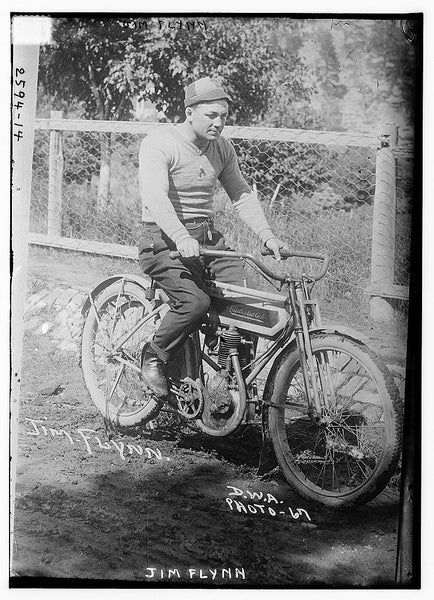
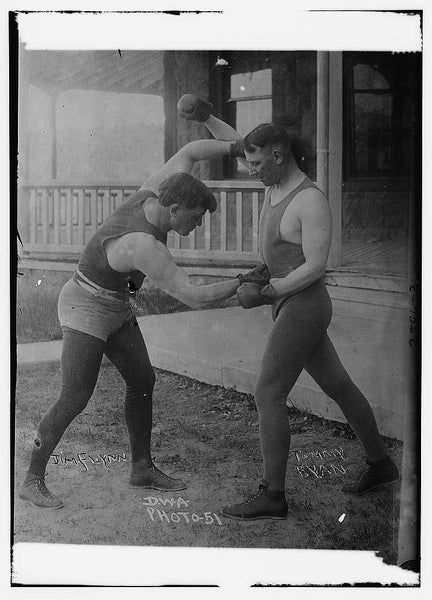



Inspiration
While researching ideas, the legendary knockout of Jack Dempsey, the Manassa Mauler combined with the workman-like boxing career of the underdog Jim Flynn inspired us to create a design honoring Flynn for Hook & Irons. Choosing the the designer was easy for this one. Steve Wolf specializes in hand-drawn art and works frequently with different sports topics. Additionally, he is a collector of vintage boxing artifacts and he seemed as excited, if not more, to bring this idea to life. As there is no poster for this event that we know of that still exists, we asked Steve to imagine a poster for the bout using the style of lettering and drawing that was popular at the time. We also asked him to draw his best rendition of Jim Flynn. The final design couldn't be more striking than the photo he worked from. We hope you enjoy the design and the small piece of history where the workman--the fireman--the boxer--the constant fighter--won one for the underdog.
The Last Great Fire of New York City - 1845 September 04 2013, 0 Comments
Before dawn on July 19, 1845 a fire broke out on the third floor of a whale oil store on New Street (located in lower Manhattan). An influx of early morning business and mild summertime temperatures might have aided in putting a quick stop to the blaze, but a warehouse located just a block away from the oil store was filled with a new shipment of salt peter (which is used in the manufacture of gunpowder). Fire spreading from the oil store extended through the warehouses iron shutters and caused, 'a series of cannon-like bursts of smoke and fire, almost like a volcano, smashing into buildings across the street. It culminated in a terrible final explosion completely engulfing the city block.' The blast was heard as far away as Sandy Hook, NJ.

The fire killed 4 firefighters (volunteers as the FDNY was not a paid department for another 20 years) and 26 citizens. Before the fire was contained and extinguished it destroyed 345 buildings and caused nearly 7 million dollars in damage. With all that devastation, the fire could have been worse. The Last Great Fire of NY was the the third in a series of horrific blazes. The first and second of which occurred in 1776 and 1835. The result of the first two fires was a change in building codes. All new buildings built in New York City had to be made of brick and mortar. This code and the newer stone buildings helped to slow the spread of the blaze and aid in its containment. The other significant aid to extinguishing the blaze was the recent completion of the Croton Resevoir which provided a steady supply of water throughout the conflagration.
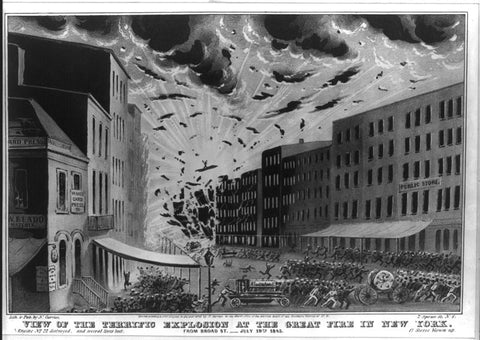
Here is an excerpt from a witness account of the blaze.
". . .an immense body of flame... it instantly penetrated at least seven buildings, blew in the fronts of the opposite houses on Broad Street, wrenched shutters and doors from buildings at some distance from the immediate scene of the explosion, propelled bricks and other missiles through the air, threw down many individuals who had gone as far as Beaver Street, spread the fire far and wide, so that the whole neighborhood was at once in a blaze, and most unfortunately covered up the [fire company's] hose.... After this the firemen could with difficulty obtain any control over the conflagration."
Inspiration
When we contacted Ryan Brown from the Pursuit of NY, we gave him very simple instructions. We wanted him to create a design that was historically significant to New York's history. We wanted it to be a fresh, new look for a t-shirt. The rest was up to him. We knew the problem wouldn't be coming up with an idea, more honing in on one great idea. The Last Great Fire tee is the result of all his research. The whale represents the whale oil store that was responsible for the blaze. The whale is also drawn into a rough shape of Manhattan and the blaze escaping from his mouth is roughly where the fire started. Located on the top and bottom of the whale are map icons for the East and North River with an anchor showing north and south and the date of the fire.

The Last Great Fire of New York City encompasses everything we look for when we make a shirt--a design that stands alone on its own merit and becomes more interesting once you learn the story behind the design. Ryan Brown is one of the great talents we've come across since starting H&I and if you're looking for cutting edge designs from one of the hippest indie labels out there, you should check him out at Pursuit of NY.
Historical Novel
While researching The Last Great Fire, I came across a mystery novel that takes place in 1845 New York and includes the The Last Great Fire in the novel. The Gods of Gotham written by Lyndsay Faye was one of Publishers Weeklys top ten Mystery/Thriller novels of the year. Lyndsay spent over a year researching the book before writing it and by all accounts is very historically accurate. Beyond that, I would recommend it as a very easy read.
The Last Great Fire of New York City changed the building codes in New York City and eventually played a part in unifying the fire service into what would become FDNY as we know it today. We're proud to release this shirt and recognize that from the ashes we rise and continue the mission of making the fire service better than it was before we found it.
The Bronx is Burning August 18 2013, 2 Comments
101 Rules for the New Firefighter April 10 2013, 93 Comments
1. When working at a new house for the first time, shut-up, work hard, and pay attention. I can promise you that everyone is paying attention to you.
2. The young firefighter knows the rules, but the old one knows the exceptions.
3. Let the tool do the work.
4. Be like a duck. Remain calm on the surface and paddle like hell underneath.
-Michael Caine
5. "Twenty-five years from now you will be more disappointed by the the things that you didn't do than the ones you did."
-Mark Twain

6. Don't make a scene and never disrespect your brother.
7. Never take the seat that faces the television when sitting at the dinner table.
8. When in doubt, take a halligan.

9. Two hands. Two tools.
-Mike Ciampo
10. Never claim to be what you're not. Time reveals all things.
11. If you don't know what you're doing, say so.
12. When approaching a fire scene, it is imperative to slow down three blocks before arrival.
13. Suck it up.
14. You shouldn't worry when the guys make fun of you. You should worry when they don't say anything at all.
15. Give Credit. Take the blame.
16. Never turn your back on the fire.
17. When things go wrong, don't go with them.
-Elvis Presley

18. Always show up to work at least a half-hour early. There is no better gift you can give to guy or gal your relieving.
19. Never trust the hand lights on the truck. Buy your own.
20. Don't gloat. Don't brag. The guys will do it for you.
21. Take pictures often.
22. Seek out the busiest units and the best officers.
23. Drink coffee.
24. Don't tell war stories to non-firefighters. No one thinks its as exciting as you do.
25. Gratitude is the sign of noble souls.
-Aesop
26. Don't be so eager to get off probation. The time you spend riding backwards will be the most fun you have in your career.
27. Never be the last one to the truck, or the sink.
28. Be the last one to bed.
29. Don't be afraid to fail
30. Drill. Drill. Drill
31. Never respond to criticism in an e-mail.
32. Surround yourself with smart people.
33. Maintain a healthy fear of this job.

- Windsor building fire
34. Stay committed to being a life-long student of the fire service
35. Share your ideas and observations. You never know it could save someones life.
"I not only use all the brains that I have, but all that I can borrow."
-Woodrow Wilson
36. Learn to cook at least two great meals.
37. Read John Norman's book, Fire Officers Handbook of Tactics
38. One fire sticker on your car is more than enough.
39. Don't complain about how many calls you had last night. No one cares. Least of all, the people that are working 9 to 5 jobs while you're napping.
40. Have pride in your department, but more for your station.
41. Be precise.
42. One of the best ways to learn is to teach--even if its teaching what you just learned.
43. Don't panic.
44. Befriend the driver. You won't get anywhere without him.
45. Go down fighting.
46. If you're carrying more than one knife, you're a moron.
47. Be careful what you put on paper or e-mails. You can't take it back.
48. Don't scribble in the logbook.
49. Learn how to swim. You don't want to be the guy that can't go near the water.
50. When you're a guest at a house (on overtime or just there for the day), follow their rules.
51. Offer to help before you are asked.
52. The phone and the doorbell are always for you.
53. Just because you have the uniform, that doesn't make you a firefighter. . .It just makes you a city, county, or government employee. Your peers will let you know if you're a firefighter or not.
54. When spending money, good quality leather boots are always worth the investment.
55. Never call out sick on a drill day.
56. If you don't have kids, Christmas is not as important to you. You should not be asking for the day off.
57. The one true measure of a successful shift is returning home safely.
58. Don't date a co-worker.
59. Carry two wedges and 20' of webbing.
60. You will find no better camaraderie than in a firehouse
61. Don't talk about the other department you worked for. No one cares.
62. Participate in a good practical joke.
63. Introduce yourself. Don't be offended when you're not remembered. You're not memorable--yet.
64. Treat your body well. You'll be glad you did.
65. Always have $20 in your wallet. No one wants to take you to the ATM.
66. Learn your territory. Know it like the back of your hand.
67. When you are out in public, never criticize your own department. You can make up for lost time on your next shift.
68. Take the stairs.
69. Don't show off. Impress.
70. When using a power saw, patience, form--not strength are needed to make the cut.
71. Choose the right blade.
72. Fire is always changing and you cannot be stationary in your attitude to something that is always changing.
73. Never criticize a fire or a call unless you were there yourself.
74. Don't wear your fire t-shirt to the gym unless you plan on giving mouth to mouth. Trust me, its never going to be the 18 year old co-ed with sweatpants that read, 'juicy' across her butt.
75. Be patient with the ER staff. They can't help that they chose such a miserable career.
76. Dorms are for sleeping. Turn the tv off and hang up the phone.
77. Don't go cheap on the ice cream and the coffee should be from Dunkin Donuts.
78. Courage is not the lack of fear, it is acting in spite of it.
-Mark Twain
79. You are what you do. Not what you say.
80. One of the most difficult and dangerous things to do on a fire scene is backing a truck up.
81. Pace yourself.
82. A fellow firefighter who is not willing to share their knowledge is suspect.
83. Avoid gossip
84. The common sense approach is usually the best way.
84. Stick to the plan. You haven't been at it as long as you think you have.
85. Follow instructions.
86. Read John Mittendorf's book Truck Company Operations.
87. Attend fire conferences. You'll see that your department is not the center of the universe and there are other guys that are already doing it smarter and better than you are.
88. Be the guy that everyone has to say, " take a break. You're making us look bad."
89. If your department allows it, invest in a leather helmet.
90. Always look up and around and read Brannigans book Building Construction For the Fire Service. If you can't make an educated guess as to how a building will perform under fire conditions, you are putting yourself in danger.
91. Demand more from your officer.
92. It is a good idea to carry a multi-tool.
93. Never defend the liar, the cheat, or the thief.
94. When your officer tells you to take a nap, it's not a joke or a trick. He wants you to be worth a damn at 3am.
95. You don't clean a seasoned cast iron skillet with soap and water.
96. Shaving your arms is not cool. It's a good way to contract MRSA.
97. I'll take the chubby firefighter that can work all day over Mr. February who has to eat six meals, drink three protein shakes, and is no good to me after one tank.
98. Always eat dinner with your crew. Your diet is not as important as family.
99. Never ask the guys to lie to your spouse when he or she calls the station.
100. When it's your time to drive, always remember that you're now responsible for all the lives in the truck.
101. The day you show up to work hungover, or sleep deprived is the day everyone is going to need you.
I've actually got more than 101, but I thought I'd like to see if anyone has anymore. That's all for now.
-George
Subscribe to our mailing list
www.hookandirons.com
Where We Stand October 25 2012, 0 Comments
Today, just over a month after the launch of Hook & Irons we have been overwhelmed by the support received from the firefighting community. We've made connections and friends in ways we would've never suspected, and received help in the most unlikely places.

Most surprising though is the support we've received from non-firefighters, friends of firefighters, and people who just appreciate the fire service. The thing about firefighters is we are a tight bunch and can be pretty exclusionary. Once we become firefighters and join the brotherhood those around us that we love often find themselves on the outside of our war stories and inside jokes. They get a glimpse into our lives and our passion, but they don't necessarily get the 'invite' to be a member.
What we're discovering is that Hook & Irons Co. is for everyone who loves the fire service. It's for everyone who respects the best of who we are and what our profession represents. And when Digital Arts magazine interviewed Tom Lane about our brand we were blown away. It's not just the firefighters that are H&I company members, but graphic artists, history lovers and people who just dig the designs, the brand, and what we all stand for.
And that is what makes us most proud. If you'd like to read the article in Digital Arts, you can click here.

Close the Book October 11 2012, 10 Comments
This week, my department released a very short, simple memo. It stated that on Monday October 8, 2012 Miami-Dade Fire Rescue would no longer maintain a hand written logbook. Perfunctory and to the point, the e-mail was sent to every firefighter in our department.
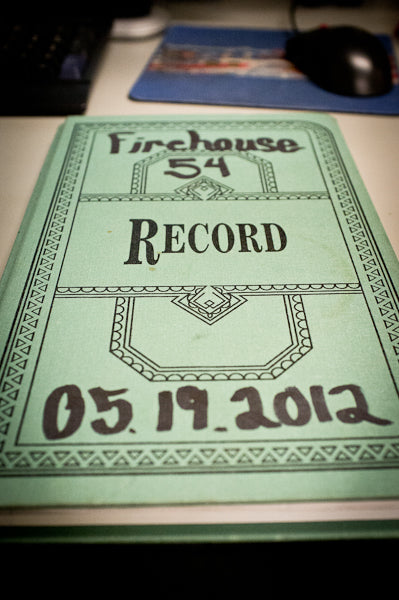
There wasn't a pause, a moment of silence, a last alarm, or even a mention of the tradition we killed in the name of efficiency. No one said a eulogy and no one rang a bell for the thousands of officers that had carefully documented everything that had happened on their watch at their station on any given day in Dade County. To think about the millions of calls our department has run in almost a hundred years is one thing. To see the volumes of logbooks that document every one of them is another.
Why was I so bothered by this change? Every other officer I talked to seemed thankful that this extra bit of work was being lifted from our shoulders. Don't get me wrong, at three o'clock in the morning there is no higher form of drudgery than sitting down and documenting some call that was anything but an emergency. Why, after five day, does this change still bother me? This was something that I had a hard time putting my head around. I'm certainly not a technology hater or a doomsday prepper. I have my iphone in my pocket. I'm on Facebook. I love having the TIC at my side going into a fire. And I'm sure the department has all of our documents secured on servers in fireproof rooms and virtual iclouds. Then it hit me.
Those logbooks--those documents written in so many different handwriting styles, are the only substantive evidence of the daily work we do. Those books are the only thing that you can pick up, feel, read, and see what that day--any day cost us. You can see it in the chicken scratch of tired officers or the careful letters of men who are not used to writing much more than their name. But most of all, you could walk in before your tour, run your finger down the column of calls and see if your brothers had a fire, a rough night, or if the gods were kind and let them sleep.
So this blog is not so much about blasting technology. It is more a warning to consider the things you leave behind in the name of efficiency.

What was lost today? Today I lost that moment in the morning when I sit with my coffee and write the names of each member of my company--that moment where I sit and consider their strengths and weaknesses and how I will use them in different situations. Sure I will still do this. I'll just have to find another way. And for me, writing these names was a reminder to myself, a contract that I am beholden to that states that I'm responsible for the safety of each firefighter at my station. If you don't believe me you can look for yourself and see it written in black and white on the page.
There isn't a blinking screen in the world that can provide that same feeling.

Pay It Forward September 20 2012, 0 Comments
Hook and Irons Co. was born with one philosophy, pay it forward. Our idea was simple; we would help the fire service reconnect with its history using the tenets of early American craftsmanship to build our apparel line. Through meaningful, simple designs, we are creating shirts that are more than shirts, they are historical threads and conversation pieces. Whether you are active, retired, volunteer or just someone who loves the spirit of the American fire service, we want you to feel proud wearing our clothing. Firefighter or not, being a part of the brotherhood is as simple as knowing where we, as Americans come from and honoring that feeling everyday of our lives.
Recently, we received an e-mail that made us proud and re-affirmed our belief in the Hook & Irons project:
" Thank you for making something that makes me feel like I'm still part of the brotherhood. I spent 10 years as a volunteer helping other people because of things I witnessed in my youth. I was not motivated by the paycheck but doing my part of being a responsible human being.
When my time with the fire service was done, I felt like I was on the outside. Sometimes hearing the comments from active firefighters has been very disheartening.
Then one day something happened. I was walking through a store and a young man walked up to me and said, " You don't remember me but you saved my life. At that moment every sore muscle and sleepless night I had on the job was worth it. I do remember you Eddie! I told him. Never in my life did I ever feel so humbled. God saved Eddie that day, I was the tool he used.
-Paul
Paul served on Engine 7474 as a firefighter / EMT at Coloma Lotus Volunteer Fire Department California 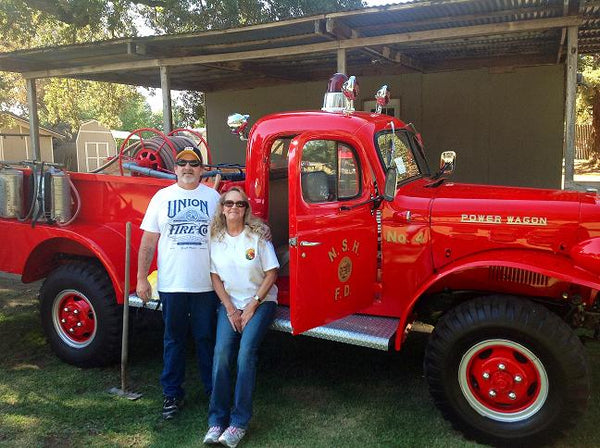
The Eagle Has Landed September 08 2012, 2 Comments
When we sat down with Tom Lane to come up with the Hook & Irons symbol, we threw around a bunch of ideas for our version of the 'Nike Swoosh', but nothing ever beat out the eagle--that proud iconic presence that sits atop most of our helmets. After doing some research on the eagle's history, we took some photographs of the eagles on our own helmets and turned them over to Tom.

The origin of the eagle on the modern fire helmet can be traced to around 1825 when an unknown sculptor created a commemorative figure for the grave of a volunteer firefighter. The figure on the grave was that of a firefighter, emerging from flames holding a sleeping child in one hand and a trumpet in the other. The figure wore a helmet with an eagle on it, which soon became part of the helmets worn by firefighters to this day.
Even though the eagle's practicality is often questioned and technology has devised better ways of affixing a firefighters unit designation to their helmet, this is one battle that time and technology has not won--yet. And we love that.
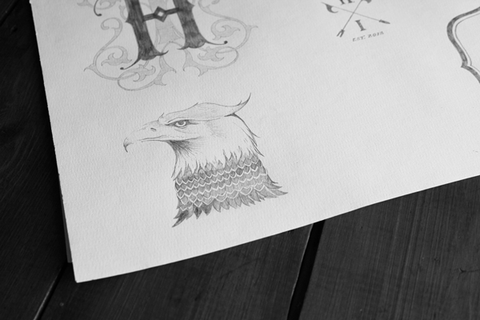
The Hook & Irons eagle was hand-drawn, painstakingly sketched and then inked. Our design was built by hand, embodying everything that is great about the fire service--everything we fear that time and technology might one day change.
Til then, wear it with pride.















